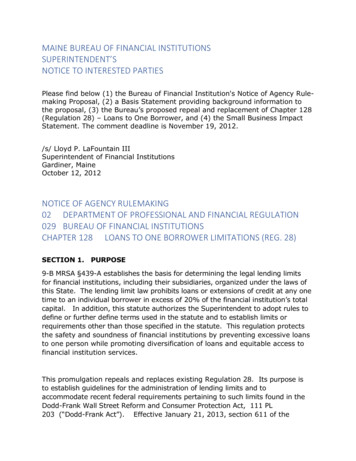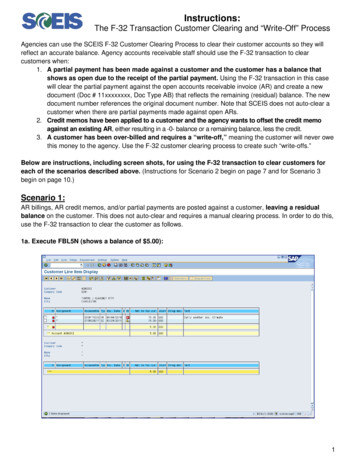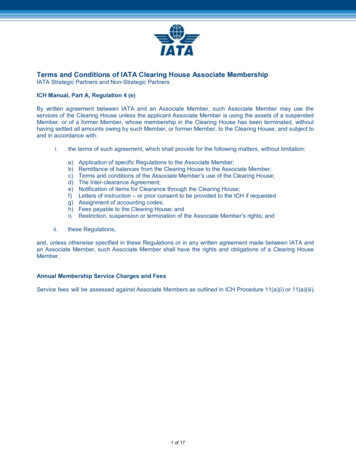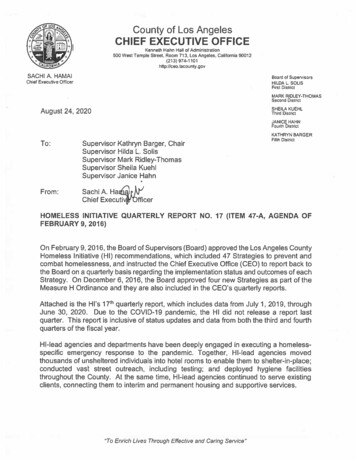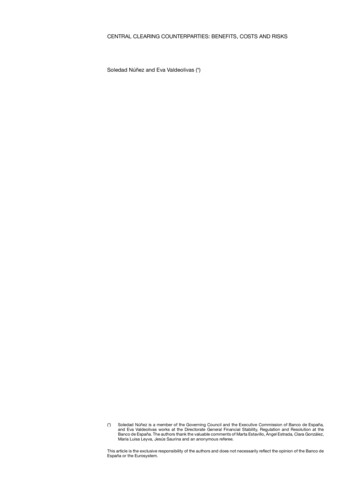
Transcription
CENTRAL CLEARING COUNTERPARTIES: BENEFITS, COSTS AND RISKSSoledad Núñez and Eva Valdeolivas (*)(*) Soledad Núñez is a member of the Governing Council and the Executive Commission of Banco de España,and Eva Valdeolivas works at the Directorate General Financial Stability, Regulation and Resolution at theBanco de España. The authors thank the valuable comments of Marta Estavillo, Ángel Estrada, Clara González,María Luisa Leyva, Jesús Saurina and an anonymous referee.This article is the exclusive responsibility of the authors and does not necessarily reflect the opinion of the Banco deEspaña or the Eurosystem.
CENTRAL CLEARING COUNTERPARTIES: BENEFITS, COSTS AND RISKSSince the international financial crisis, central clearing counterparties (CCPs) have assumeda key role in the over-the-counter (OTC) derivatives market. One of the factors behind thisincrease in activity is the G20 requirement to centrally clear standardised OTC derivatives.This initiative rests on the belief that centralised clearing can help reduce counterparty risk,and the systemic risk associated with OTC derivatives markets. But risk concentration inCCPs (chiefly counterparty risk), potential loss mutualisation in the event of one or moreclearing members defaulting and the high interdependencies with the rest of the financialsystem entail significant consequences for financial stability. Hence international agencies,such as the Financial Stability Board (FSB) and the European Commission and otherregulators, are working on initiatives to strengthen their soundness and the capacity forrecovery and resolution in the event of crisis. From the banking perspective, the analysis ofthese entities is significant insofar as a big portion of clearing members are banks.Accordingly, any tool aimed at ensuring the continuity of the CCP will have a direct effecton them. This article analyses the functions of a CCP, its risks and the tools available forfacing losses given the role that banks play in centralised clearing.1Central clearing counterparties (CCPs) are financial entities that interpose themselves, inIntroductiontheir own name, in financial instrument trades, becoming a seller to each buyer and abuyer to each seller.1 Through a process known as novation, each trade cleared througha CCP is converted into two transactions, with both having the CCP as a counterparty.While its net position is zero, the CCP assumes the counterparty risk of both the purchaserand the original seller, both being clearing members. To protect itself against this risk, theCCP establishes lines of defence that include initial and variation margins to positions,members’ contributions to a default fund and a buffer of its own capital, with a welldefined default waterfall established in its regulation.Centralised clearing began to develop over a century ago, linked to the organisedexchanges where highly standardised derivatives (ETD or exchange-traded derivatives),such as bond and stock market futures and options, are traded. In parallel, and above allin the 80s and 90s, OTC derivatives markets and products such as swaps, credit defaultswaps (CDSs) and exchange rate derivatives, in which trading and clearing were bilateral,were progressively developed. Since then, both markets have existed alongside oneanother, serving different needs of their participants, with much activity and each with acertain degree of specialisation. However, before the crisis, some CCPs had already begunto offer centralised clearing of instruments traditionally cleared bilaterally, such as swaps,CDSs, repos and even shares.212BANCO DE ESPAÑA73Clearing is the set of processes that take place after the trading of a transaction and before settlement (e.g.payment versus delivery of securities). Specifically, clearing involves determining the obligations and entitlementsof the parties. It also includes the possible netting of obligations between buyer and seller. Clearing can bebilateral (between the buyer and seller) or centralised, through a CCP. In that case, the CCP becomes the buyerto the seller and the seller to the buyer. Trading can also be bilateral (OTC markets), or through organisedexchanges (e.g. on a stock exchange).For example, in 1999 LCH Ltd began to clear interest rate swaps. In 2009, ICE Clear Credit US and ICE ClearEurope Limited began to clear CDSs. Notably, in some jurisdictions such as Spain, centralised clearing of stockmarket equity transactions is obligatory. In the United States, for example, transactions with listed bond andexchange trade funds are also cleared.FINANCIAL STABILITY REVIEW, ISSUE 36
The financial crisis highlighted the differences between bilateral and centralised clearing.Firstly, whereas the centrally cleared derivatives markets proved relatively stable, theopaqueness and complexity of the OTC derivatives markets hampered the valuation ofthe positions held by financial institutions, fuelling mistrust and generating bouts of acutevolatility.Secondly, the centralised clearing markets were seen to be more resilient for absorbinglosses. For example, when Lehman Brothers collapsed, it was one of the most activeparticipants in the interest rate swaps (IRSs) segment of the London clearing house LCHLtd. In particular, the bank had an outstanding position for 9 of the 100 trillion cleared inthis segment. Despite the volume of exposure, it was possible to resolve the bank’s failurethrough the auctioning of its positions and the use of the collateral posted by Lehman,without any other participant incurring losses [see Monnet (2010) and Gregory (2014)].The shortcomings on the OTC derivatives markets prompted G20 leaders, meeting inPittsburgh in 2009, to agree to an ambitious reform package. The aims were to enhancetransparency, prevent market abuse and mitigate systemic risk. The G20 authoritiescommitted themselves to having all standardised OTC derivatives contracts traded onelectronic trading markets or platforms and centrally cleared before end-2012. In the caseof bilaterally cleared contracts it was agreed, with the aim of encouraging centralisedclearing, to raise capital requirements of banks, to require margins on positions and toimprove their transparency through the recording of trades in a repository [see G20Research Group (2009) and FSB (2018 a)]. This package has given rise to legislativechanges at the national level. In Europe, for instance, the agreement was incorporated in2012 through the European Market Infrastructures Regulation (EMIR), and in the successivetechnical standards drawn up by the European Securities and Markets Authority (ESMA).In the United States it was passed in 2010, through the Dodd-Frank Wall Street Reformand Consumer Protection Act. Significantly, the timing of the implementation of theseobligations has differed in terms of instruments and across jurisdictions.3Mandatory centralised clearing has posed a significant challenge for CCPs. It involves aconsiderable increase on one hand in the volume of positions to be cleared, and, on theother, in more complex and less standardised products. In 2007, the clearing of OTCderivatives was essentially bilateral: only 17% of interest-rate derivatives (swaps andFRAs) were centrally cleared.4 By contrast, as at June 2018, this proportion had risen to76%. In the case of CDSs, the increase in positions cleared in CCPs has also beensignificant, exceeding 50% of outstanding positions as at mid-2018.CCPs are not free from risks. First, even when they can reduce the overall exposure tocredit risk, by setting themselves up as counterparties in all transactions, they concentratethat risk; and, by means of the lines of defence they set up, they mutualise and distributeit among their clearing members. Further, CCPs are also subject to operational and liquidityrisk. Moreover, on assuming the counterparty risk of all outstanding contracts, CCPs arehighly exposed to other financial agents. That means that the failure of one of its membersmay translate into losses for the CCP and vice versa. It is thus essential to ascertain whichfinancial institutions act as counterparties and their degree of activity.34BANCO DE ESPAÑA74For example, the centralised clearing of interest rate swaps (in yen) has been obligatory in Japan since November2012 and, in the United States (in the main currencies), since March 2013 (see Annex 1).Interest-rate derivatives account for approximately 81% of the total derivatives traded on OTC markets.FINANCIAL STABILITY REVIEW, ISSUE 36
The Financial Stability Board (FSB) has pursued an avenue of research focusing on theanalysis of interdependencies between CCPs and their clearing members. Drawing ona study of 26 global CCPs, it concludes that clearing activity is highly concentrated in asmall number of clearing members which, moreover, are common to several CCPs [seeFSB (2018b)]. Moreover, a big portion of these members are banks. Indeed, the globalsystemically important banks (G-SIBs) generally clear in several CCPs. Consequently, inthe absence of appropriate risk-management mechanisms, the default of a global bankmight generate losses at several CCPs which, in the event of failure, would affect allparticipating banks and the other members.The systemic nature of CCPs explains why they are highly regulated and supervisedentities; the aim is to ensure their soundness, and prudent and transparent riskmanagement. Moreover, they need to have an orderly recovery and resolution frameworkin place and, given the high degree of interdependencies with banks and other entities inthe financial system, it is vital this framework should ensure effective coordination betweendifferent supervisors.This article examines the functioning and resilience of CCPs in order to understand not onlythe advantages linked to centralised clearing, but also the risks this imposes on banks in theircapacity as participating entities. Section 2 describes the activity on derivatives markets andthe activity of CCPs at the aggregate and individual level. The aim is to ascertain the volumeof the market studied in this article and its degree of concentration. Section 3 explains whata CCP is, how it is structured and the role banks play. Then, in section 4, an analysis followsof the mechanisms that enable CCPs to absorb the losses caused by a member’s default,and section 5 assesses the possible recovery and resolution tools. Section 6 summarises thecosts and benefits of centralised clearing, and its implications for financial stability. Finally,section 7 draws the main conclusions.2Chart 1.1 shows the large size of the OTC financial derivatives market and describes theThe activity of CCPsmarket’s growth, in terms of notional outstanding volumes5, over the 1998-2017 period. It2.1 THE SIZE OF THE OTCcan be seen that, in outstanding balances, the size of the OTC market is much greater thanDERIVATIVES MARKETthat of the ETD markets, even adjusting the OTC derivatives series for possible doublecounting.6 OTC derivatives grew substantially in the years running up to the financial crisis,tripling in size from 2004 to 2008, when they attained a notional value of 647 trillion. Since2013, a declining trend has been seen. This trend could be explained by the shift towardscentralised clearing, as the obligation to clear through a CCP progressively took root. Aswill later be seen, central clearing facilitates multilateral netting of positions and portfoliocompression.7 Conversely, this declining trend is not observed in traded volumes (notaffected by netting).In contrast to the outstanding volumes, the activity of the OTC derivatives markets interms of trading is somewhat smaller in size than the market for futures and options. In this567BANCO DE ESPAÑA75The outstanding volumes of OTC derivatives can be measured in two ways: by notional value or by market value.Notional value is generally the face value of the underlying asset and market value is the price at which thederivative is bought or sold (without including commission, charges or taxes). For example, In a 10-year swap fora nominal value of 100 million that receives a fixed rate of 3% per annum and pays a 3-month EURIBORvariable rate on each payment date, the notional value is 100 million and the market value is the present valueof net future flows (fixed-variable).As explained in Annex 2, the BIS data on OTC derivatives may include double counting that affects thosetransactions originally traded between the banks that report to the BIS, and which are subsequently centrallycleared. The adjusted series estimates this double counting and deducts it from the original series.Reducing then outstanding position. See Annex 3.FINANCIAL STABILITY REVIEW, ISSUE 36
ACTIVITY IN DERIVATIVES MARKETSCHART 11 OUTSTANDING POSITIONS (NOTIONAL VALUE)800,000At half-year end, USD bn2 TRADING (NOTIONAL VALUE)10,000Daily average, USD -98 Feb-01 Oct-03 Jun-06 Feb-09 Oct-11 Jun-14 Feb-17F&O (a)OTC DERIVATIVES (b)OTC DERIVATIVES (ADJUSTED) (b) (c)019951998F&O (a)200120042007201020132016OTC DERIVATIVES (b)SOURCE: BIS (Semiannual Derivative Statistics and Triennial Survey).a Futures and options on interest rate and exchange rate traded and cleared on organised markets.b Includes OTC interest rate and foreign exchange derivatives and CDSs.c Series adjusted for possible double counting (see Annex 2).latter market the maturity of contracts is shorter and turnover much greater. Thus, in 2016(the last year with available information on OTC derivatives), average daily trading in OTCderivatives was 6.1 trillion and that in futures and options 8.8 trillion (see Chart 1.2).Chart 2 depicts the outstanding volumes by OTC derivatives instrument, both in notionalvalue and in market value, being the latter much lower. The largest market is, by far, that ofswaps and other interest rate derivatives (IRD).8,9Both the swaps and CDS markets grew substantially in the years running up to the financialcrisis, respectively increasing 2.5 and 9.5 times. After the crisis, the CDS market shrankdrastically. The size of the swaps market has declined in terms of outstanding volumessince 2013. This reduction is, at least partly, due to the shift towards centralised clearingand to the subsequent netting and portfolio compression of a considerable number ofpositions, as mentioned above.10The percentage of swaps and CDSs centrally cleared are shown in Chart 3. These two2.2 CENTRALISED CLEARINGinstruments are those which, largely, are subject to the obligation of CCP clearing.11 AsACTIVITYcan be seen in the chart, the proportion of swaps and FRAs and of CDSs that are clearedthrough a CCP has been growing notably since the obligation for centralised clearingbegan to be introduced (late 2012-early 2013, see Annex 1). However, in the case ofswaps, this percentage was already of some size previously. As regards other OTCderivatives, not subject to the obligation of CCP clearing, such as foreign exchange891011BANCO DE ESPAÑA76Interest rate derivatives include swaps, FRAs and options. The largest market is for swaps, followed by FRAs.The interest rate options market is much smaller.As at December 2018, Spanish significant institutions held OTC derivatives on their balance sheets (consolidateddata) for a notional amount of 10.77 trillion, 74% of which were interest rate derivatives other than options (i.e.swaps and FRAs).See Annex 3.Neither all swaps nor all CDSs are subject to the centralised clearing obligation. For a list of those that are, seeAnnex 1.FINANCIAL STABILITY REVIEW, ISSUE 36
DERIVATIVES BY INSTRUMENT. OUTSTANDING POSITIONSCHART 21 NOTIONAL VALUE700,000USD ,00030,000200,00020,000100,00010,000USD bn0Jun-98 Feb-01 Oct-030Jun-98 Feb-01 Oct-03 Jun-06 Feb-09 Oct-11 Jun-14 Feb-17Jun-06 Feb-09 Oct-11Jun-14 Feb-17EQUITY-LINKED DERIVATIVESCDSsCDSs (ADJUSTED) (b)SWAPS AND OTHER IRD (a)FOREIGN EXCHANGE DERIVATIVESSWAPS AND OTHER IRD (ADJUSTED) (a) (b)2 GROSS MARKET VALUE25,000USD bn6,000USD 0Jun-98 Feb-01 Oct-03 Jun-06 Feb-09 Oct-11 Jun-14 Feb-170Jun-98 Feb-01 Oct-03SWAPS AND OTHER IRD (a)FOREIGN EXCHANGE DERIVATIVESSWAPS AND OTHER IRD (ADJUSTED) (a) (b)Jun-06 Feb-09 Oct-11Jun-14 Feb-17EQUITY-LINKED DERIVATIVESCDSsCDSs (ADJUSTED) (b)SOURCE: Prepared by the authors on the basis of data supplied by BIS (Semiannual Derivative Statistics).a Data includes FRAs and Interest Rate Options.b Serie adjusted by potential double counting (see Annex 2).derivatives and equity linked derivatives, the percentage of centralised clearing is very low(5% and 0.3%, respectively, in June 2018).In 2007, the percentage of centrally cleared swaps was 17% (9.3% in the adjusted series),while in June 2018, this proportion had risen to 76% (62% in the adjusted series). For CDS,these percentages rose from 14% in 2010 (8% in the adjusted series) to 54% in 2018 (37%in the adjusted series). This notable increase in the proportion of centrally cleared OTCderivatives (especially in the largest market, that for swaps) implies that the activity ofCCPs has increased substantially.Significantly, the percentage of centrally cleared swaps is somewhat higher than wouldcorrespond to the strict fulfilment of the obligation to clear through CCPs. Hence, ISDA(2018) indicates that, according to the information drawn from the US Commodity FuturesTrading Commission (CFTC), in 2016 at least 7% of centrally cleared swaps were notsubject to the obligation to clear, with this percentage standing at 3% in 2017.BANCO DE ESPAÑA77FINANCIAL STABILITY REVIEW, ISSUE 36
CENTRAL CLEARING IN OTC DERIVATIVES. PERCENTAGE OF NOTIONAL AMOUNT OUTSTANDINGCHART 31009080706050403020100Dec-07Dec-09SWAPS (a)Dec-11SWAPS (ADJUSTED) (a) (b)Dec-13CDSsDec-15CDSs (ADJUSTED)Dec-17SWAPS (TRADING) (c)SOURCE: Prepared by the authors on the basis of data supplied by ISDA and BIS (Semiannual Derivative Statistics).a Data includes FRAs. Data prior to 2016 has been estimated by applying to BIS data the rate of change of the data reported by ISDA. Since 2016, data arereported by BIS.b Serie adjusted by potential double counting (see Annex 2).c Data includes FRAs and refers to trading (source: ISDA).2.3 THE CONCENTRATION OFChart 4 shows the shares of activity of the different CCPs, by market segment,CENTRALISED CLEARINGhighlighting the fact that centralised clearing is a highly concentrated activity.12 In theACTIVITYcase of Europe, this concentration is apparent in the different market segments. It isvery notable in that of futures and options, CDSs and, above all, in swaps, where theLondon CCP LCH Ltd concentrates practically all activity.13The high concentration of centralised clearing in LCH Ltd also recurs at the globallevel. This can be seen in Chart 4.2, which shows the shares of activity, for the swapssegment, across different CCPs by currency and region. The lower share (44%) is inyen-denominated swaps, the markets in which the Japanese authorities impose certainrestrictions that constrain clearing in foreign CCPs.Globally, the centralised clearing of CDSs also shows a very high concentration (seeChart 4.3). Here it is the US CCP ICE Clear Credit that shows a high share, exceeding 70%for the CDS market as a whole, followed by the British CCP ICE Clear Europe (of the samegroup), with a share of 20%.This high concentration of centralised clearing means that the increase in clearing activity(largely induced by the obligation to clear centrally) has materialised in very few entities,giving rise to a high concentration of risk and, accompanying this, to a heightening of itssystemic nature.12 This high concentration is partly due to economies of scale and to the greater possibilities of netting and contractcompression offered for market participantss when they concentrate their clearing activity in just a few CCPs.13 In the course of 2018 a slight shift in clearing was seen from LCH Ltd towards the German CCP Eurex (asobserved in Chart 4.2). This shift is attributable to Brexit, since – in the absence of a transitory period – followingthe UK’s withdrawal from the EU and until LCH Ltd were declared a Qualified CCP, European banks would faceregulatory constraints to operate or hold positions in British CCPs. Nevertheless, in December 2018 the EuropeanCommission published a decision where under it considers British CCPs equivalent for a temporary period.BANCO DE ESPAÑA78FINANCIAL STABILITY REVIEW, ISSUE 36
CENTRAL CLEARING BY CCP AND SEGMENTMarket shares (%)CHART 41 EUROPEAN CCPs 5.54.116.08.28.43.4RepoSpot200BMECC&G (IT)90EUREX (DE)ICE (UK)8040F&OLCH SA (FR)EU CCP (NL)7470OTHER73626056506050LCH LTD (UK)80102470Swaps & FRAs3 GLOBAL CCPs. CDSs (c)190.60.4CDS2 GLOBAL CCPs. SWAPS AND FRAs AsiaLat. Am.EMEA20182044USD35307430204000.08 3440.03 3330.04 30CDS (single name)CDS IndicesOTHERSHANGHAI (CN)ASX (AU)CME (US) (d)ICE (US)JSCC (JP)EUREX (DE)CME (US)JSCC (JP)LCH SA (FR)TotalICE (GB)LCH LTD (UK)SOURCES: ECB (Chart 4.1) and Clarus FT (Chart 4.2 and Chart 4.3).abcd2017 data.2018 data.2015-2017 data.CME (US) ceased clearing the CDSs segment in 2018.As mentioned, CCPs are entities that interpose themselves in their own name in financial3 CCP functioning andparticipantsinstrument contracts, becoming a seller to each buyer and a buyer to each seller. When anoperation is registered in a CCP it gives rise to a purchase transaction and a saletransaction, with both having the CCP as a counterparty (see Diagram 1). In this way, theopen position of the CCP is zero and, if because of a member’s default the position werenot thus, the CCP would have to act immediately to return to the net zero position (amatched book). That said, by interposing itself, in all contracts, the CCP is exposed tocounterparty risk, both with the original buyer and with the original seller.14,151415BANCO DE ESPAÑA79Counterparty risk is defined as the risk of the counterparty not meeting its obligations. The obligations with aCCP are: to post and replace the initial margin; to post, where appropriate, the variation margin; and thoseobligations arising from the purchase or sale of the security upon maturity of the contract.For a detailed description of the functioning of a CCP, see Gregory (2014).FINANCIAL STABILITY REVIEW, ISSUE 36
MULTILATERAL NETTING IN A CCPDIAGRAM 1Central clearingBilateral clearingAA 100 20 120 100CBCCP 80C 200Total Exposure 420BTotal Exposure 200As will later be seen, one of the main benefits that centralised clearing offers is to facilitatethe netting of positions for participants (members).16 As the CCP is counterparty to all thecontracts, positions of the opposite sign are automatically netted, thus reducing oreliminating the participant’s exposure, both in terms of market and of counterparty risk(see Diagram 1). Conversely, in bilateral clearing, positions of the opposite sign will reducethe participant’s exposure to market risk, but not to counterparty risk (nor the attendantobligations), unless the counterparty entity is the same in the positions being netted.17CCPs are closed clearing systems and only operate with those entities that are members3.1 CCP PARTICIPANTS:MEMBERS AND THE ROLEand, through these, with entities that act as clients. To act as a member, CCPs impose aOF BANKSseries of requirements relating, for example, to solvency and members’ operating capacity,with the aim of lessening default risk.Most CCPs have at least two types of members: non-clearing members that operate onlyon their own account (through a clearing member), and clearing members that clearcontracts on their own account and some also on behalf of clients. In turn, there are twomodels in the relationship between the client and the clearing member: the principal model(predominant in Europe), in which the clearing member acts as a counterparty to the client,performing as well a mirror transaction with the CCP (see Diagram 2); and the agencymodel (predominant in the United States), in which the member manages clients’ accountsand guarantees its obligations, being the CCP the counterparty to the client. There are twotypes of client accounts: individual accounts, in which the client’s positions are individuallyrecorded; and omnibus accounts, in which the positions of several clients are recorded. Inthe case of omnibus accounts the clients’ initial margin can be posted on a gross basis (i.e.by aggregating the initial margin of each client’s position) or on a net basis (i.e. the initialmargin stemming from netting the clients’ positions).1617BANCO DE ESPAÑA80CCPs also provide for portfolio compression, which is a netting technique whereby two or more counterpartiesreplace their positions with another of less notional value and the same market risk. Annex 3 describes theeffect of netting and portfolio compression on the outstanding balance of one of the main CCPs.In the example in Diagram 1, in the case of bilateral clearing, entity A has market risk of 20, but counterpartyrisk of 120 with entity B and of 100 with entity C.FINANCIAL STABILITY REVIEW, ISSUE 36
PRINCIPAL-TO-PRINCIPAL CLEARING MODEL (EXAMPLE)DIAGRAM 2TRADINGsellClient BClient of Member CMember er AMember CbuysellClient BIn the event of a member defaulting, the CCP will close its positions and transfer itsclients’ positions to another or other clearing members (this characteristic is known asthe portability of client accounts). This transfer is less complex in the case of individualaccounts, as it is easier to identify each customer’s positions. Chart 5 shows the typeof account and the initial margin posted by clearing members and clients, for a set ofCCPs. It can be seen how, in a good number of CCPs (particularly those with mostactivity), clients’ total positions exceed those of the clearing members and, omnibusaccounts in which the clients’ initial margin is posted on a gross basis are morefrequent.While any entity that meets the minimum requirements set by a CCP can gain memberstatus, in practice, a high percentage are banks. Chart 6 shows, by segment of activity,the number of banks that are clearing members for a set of CCPs. With very fewexceptions (especially in the futures and options segment) the substantial weight ofbanks as clearing members is apparent. In the particular case of the London clearinghouse LCH Ltd, for example, approximately 86% of participants in the swaps segmentare banks. This figure is significant in that LCH Ltd concentrates practically all swapscontracts that are cleared in Europe and a very high percentage of those clearedglobally. The swaps market is, moreover, the most active of the OTC derivativesmarkets (see Section 2).The role of banks in centralised clearing takes on particular significance in the case ofglobal systemically important banks (G-SIBs). Indeed, the more systemic the bank is, thegreater the number of CCPs in which it is a member: Citigroup and JP Morgan, for example,clear in practically all the CCPs with most activity (see Chart 7.1). CCPs, for their part, aregenerally exposed to at least 10 global banks (see Chart 7.2). In Spain’s case, SantanderBANCO DE ESPAÑA81FINANCIAL STABILITY REVIEW, ISSUE 36
TYPE OF CLIENT ACCOUNTS AND INITIAL MARGINCHART 51 TYPE OF CLIENT ACCOUNTS2 INITIAL MARGIN POSTED BY CLIENTS AND CLEARING MEMBERSbn Contado/reposF&OSwaps &FRACME (US)NASDAQ (SE)JSCC (JP)LCH Ltd (UK)CME (US)OCC (US)ICE US (US)ICE EU (K)JSCC (JP)EUREX (DE) (c)BME (ES) (c)CC&G (IT) (c)FICC (US) (d)LCH SA (FR)ICE CC (US)ICE EU (UK)JSCC (JP)CDSCDSSpot/reposF&OSwaps &FRA%020406080CME (US)NASDAQ (SE)JSCC (JP)LCH Ltd (UK)CME (US)OCC (US)ASX (AU)ICE US (US)ICE EU (UK)JSCC (JP)EUREX (DE) (c)BME (ES) (c)CC&G (IT) (c)NSCC (US)FICC-GSD (US)FICC-MBSD (US)LCH SA (FR)LCH Ltd (UK)ICE CC (US)ICE EU (UK)JSCC (JP)LCH SA (FR)100020406080INDIVIDUALIM OF CLIENTS POSTED IN GROSS TERMS (a)OMNIBUSIM OF CLIENTS POSTED IN NET TERMS (b)SEGREGATED BUT OPERATIONALLY OMNIBUSIM OF MEMBERS100120COMBINED WITH CLEARING MEMBER'S OWN ACCOUNTSOURCE: CPMI-IOSCO Quantitative Disclosure, Q4 2018, published on the websites of the CCPs listed.a Initial margin calculated on clients' positions on a gross basis.b Initial margin calculated on clients' positions on a net basis.c For BME this refers to the repos segment, and for CC&G, the equities segment. Eurex reports jointly for all the segments (assigned to F&O since this is thesegment of most activity).d FICC includes FICC-MBSD, FICC-GSD and NSCC, all of which belong to the DTCC group.and BBVA are clearing members of 12 and 7 CCPs, respectively. In turn, the Spanish CCPBME Clearing operates with 15 large banks.In addition to the types of clearing members, it is important to ascertain whether clearingactivity is concentrated or not in a small number of participants. In this case, default by aparticularly active member might result in significant losses for the CCP. Globally, thisscenario appears to be the case: the 20 biggest clearing members amass 75% of clearingactivity18 [see FSB (2017a)]. Given that banks are the most common members (see Chart 6),it is reasonable to think that a big portion of the most active members are banks. Thedegree of concentration of the positions of CCP members can also be seen in Chart 8,which shows the percentage of total initial margins posted by the five most active clearingmembers in each of the main CCPs. Chart 8 also shows that the concentration is evenhigher in the client’s activity, although the number of members that clear contracts onbehalf of clients is, generally, low (see Chart 6).Banks’ relationship to CCPs is not confined to their role as clearing members. They mayalso be critical services providers. Indeed, more than half of the en
1 Clearing is the set of processes that take place after the trading of a transaction and before settlement (e.g. payment versus delivery of securities). Specifically, clearing involves determining the obligations and entitlements of the parties. It also includes the possible netting of obligations between buyer and seller. Clearing can be





